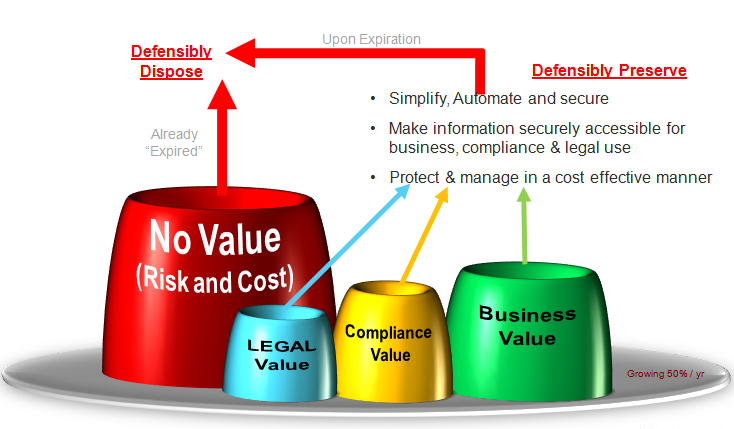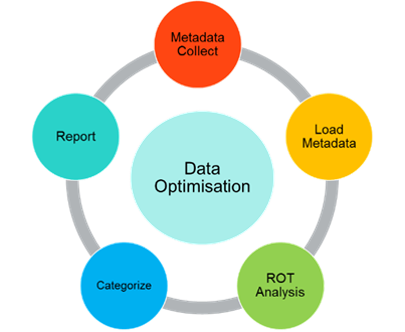Unstructured Data File Optimisation
A – Archive First, B – Backup Less and C – Consolidate more
Background.
Data Information Management is more critical than ever in today’s dynamic business climate. Few organisations have the resources and time to manually manage and maintain the “Information Lifecycle” of data within their companies, whilst also planning for future data growth. Simply adding more storage capacity every time capacity is exceeded only adds and compounds the infrastructure management burdens, creates potential points of failure, and consumes precious IT resources and budgets.
The seamless, smooth and continual operation of many IT business services often depend on the availability, performance, capacity and health of the storage infrastructure. As the business and IT environment grows, it becomes all too easy for the storage of data to become disorganised, generally unhealthy and unmanaged.
It has become generally reported and publicised by many leading IT analysts that on average 32% of organisation’s unstructured data can be classified as Redundant, Obsolete or Trivial (ROT), which if left unchecked will consume increasing and avoidable amounts of storage.
The Data Information Optimisation service provides a detailed analysis and report, based upon a selective data sample, representative of an organisation’s unstructured dataset. The findings from this analysis provides an invaluable insight into the level of data file duplication, individual data file size/aging characteristics and the immediate identification of data files with zero business value (whilst also enabling the initial steps into the creation of a data disposition and management strategy).
Service Deliverables.
Firstly, a general purpose unstructured Data Information “ROT” analysis. This analysis will immediately identify areas of cost savings, by the identification of:
- Redundant Data Files – data files that contain identical content (duplicate data files).
- Obsolete – data files whose “Business Value” has reduced to a point where the data file contents have not been “Accessed” for multiple years (>5yrs)
- Trivial – Data files which are classified as not company related (Trivial data type classification defined on an individual engagement basis).
Secondly, provides invaluable insights into how data backup time could be significantly reduced and optimised (via the future deployment of intelligent archiving and stubbing techniques).
Thirdly, provides a snapshot insight into the rate at which the business is consuming storage. By utilising this information, organisation can begin to formulate and implement a defensibly disposed policy.
And fourthly, ensuring that future IT infrastructure investments are based upon how the business accesses, utilises and manages it data sets.
Service Activities.
Figure 1. Data Optimisation Methodology.
This service provides the following key tasks/deliverables:
- Pre-Installation site visit, the technical specialist will attend site to collect detailed information regarding the Dataset under study. This is a technical data gathering, technical exchange exercise and therefore it is critical that the correct people and parties are available and included.
- Be made aware of potential storage subsystem problems/bottlenecks and possible remedial actions.
- (Optional) On-site activities i.e.
o Identify data types that can be defined as “Trivial” i.e. BMP, MP3.
o Start metadata collection (via the Remote Analysis tool).
- Off-site activities i.e.
o Perform initial analysis (ROT, data type, growth…).
o Define data categories.
o Create Metadata subset(s) for additional detailed analysis.
o Create final report including appropriate recommendations.
- Findings and recommendations to be presented and discussed with the customer at the customer’s site after the written report has been received by the customer
Service Exclusions.
It is important to note that this service specifically excludes the following:
- Any remedial activity. However, if assistance is required to address some or all of the findings, it is suggested you request details of additional packages or consultancy services
- Any configuration changes.
- Any Capacity Planning or detailed monitoring of the system.
- A hardware/patch audit of the system.
Delivery Pre-Requisites.
To ensure this product is delivered efficiently and effectively it is critical that the customer.
- Ensures that any user departments and associated technical, support or engineering staff have been correctly briefed as to importance of this project.
- Ensures that technical assistance is made available as and when requested by the technical specialist performing this study.
- The customer identifies the single (One) directory (UNC path) that will be indexed using the Remote Analysis tool.
- The Metadata files generated by the Remote Analysis tool will be copied to the appropriate removable media for off-site analysis.



